Round The World and other travels
A frequent flyer's collection of trip diaries
This is: Bohemian Rhapsody (2014)
Fairytale town with a fairytale castle
As feared, it proved impossible to get any decent sleep in our hideously overheated room. Bruce, a fully signed-up fresh air fiend, was the worse affected, but even I found the environment intolerable. I was vaguely aware, through a haze of light dozing, that a maintenance man had been in the room and had left with nothing more helpful than a shrug of the shoulders. I was much more awake sometime between 2 and 3, and lying in an unfamiliar world lit by the glow of a laptop screen, when Bruce announced that he had found an excellent Saturday-night deal on a room in our intended day trip destination, Český Krumlov, and was on the point of booking it. I consented without hesitation. I didn't care if we had to pay for the unused second night in Budweis, although in the event Bruce also saw to it that this did not happen. There are a few fundamental requirements of any hotel room, in the absence of which nothing else really matters, and high on that list is the ability to have a good night's sleep.

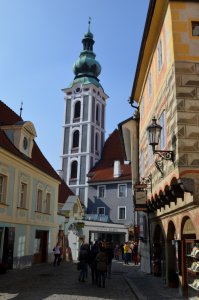 And so it came about that around 11am on Friday morning, we arrived in
our final destination not as day trippers from Budweis, but all set
for an unscheduled night stop. Our latest destination was, once
again, a place whose name seemed to have more than its fair
share of issues. The Czech version, Český Krumlov, is not
difficult to say, but people tend to find those unusual accented
letters a little intimidating. In German, it's known as Krummau
an der Moldau (literally, Krumlov-on-the-Vltava) and again, as
part of the former Sudetenland, this was once the town's
genuine name. I gather
that the name has been anglicised as 'Crumlaw' in the past, but
this somehow feels like a step too far and most modern English texts appear to state
either the full
Czech name with the
accents removed, or simply 'Krumlov'. From this point
on, I'm going with the latter
option.
And so it came about that around 11am on Friday morning, we arrived in
our final destination not as day trippers from Budweis, but all set
for an unscheduled night stop. Our latest destination was, once
again, a place whose name seemed to have more than its fair
share of issues. The Czech version, Český Krumlov, is not
difficult to say, but people tend to find those unusual accented
letters a little intimidating. In German, it's known as Krummau
an der Moldau (literally, Krumlov-on-the-Vltava) and again, as
part of the former Sudetenland, this was once the town's
genuine name. I gather
that the name has been anglicised as 'Crumlaw' in the past, but
this somehow feels like a step too far and most modern English texts appear to state
either the full
Czech name with the
accents removed, or simply 'Krumlov'. From this point
on, I'm going with the latter
option.
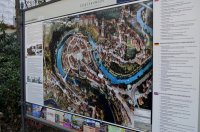 |
| ABOVE: Overall layout |
Situated in the rolling countryside of South Bohemia, about 66km north of Linz, Austria and at a spectacular horseshoe bend in the River Vltava, Krumlov certainly has an interesting location. There are two main historic areas: the old town core on the peninsula formed by the sweeping turns of the Vltava, and the 13th-century castle and surrounding Latrán district on the 'outer' bank of the twisting river. Having been allowed to fall into a state of disrepair during the Communist era, the town was inscribed as a UNESCO World Heritage Site in 1992 and has since been beautifully restored to the point where the local population of around 13,000 people is frequently swamped by the influx of tourists. The architecture is a pleasing blend of Gothic, Renaissance and Baroque elements.
The town was certainly looking its best as we set out from our new base, the Hotel Bellevue, in glorious midday sunshine. Being located in Latrán, the first obvious step was to walk downhill to the bridge leading across the Vltava and into the central core of the town.
 |
 |
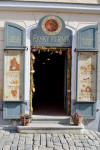 |
 |
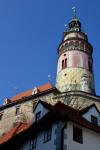 |
 |
 |
 |
 |
Even that short initial walk proved to be entrancing, with picturesque views opening up every few steps along the way. After pausing on the bridge to take in our surroundings, we continued onwards to the main Old Town square and then followed a gently climbing street eastwards towards the Hotel Mlýn, situated at the spot where, perhaps some day in the distant future, the Vltava will decide to take a shortcut and leave Krumlov largely surrounded by a lake. From this spot, more excellent views were available of the Old Town and across to Krumlov Castle and Latrán, where our walk had begun.
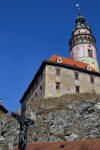 |
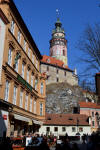 |
 |
 |
 |
 |
 |
 |
 |
 |
 |
 |
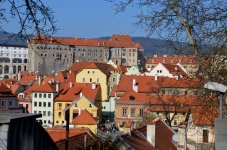 |
 |
||
| ABOVE: After lunch, starting the climb up to the castle | ||
Following a brief visit to the improbably slender-looking St Vitus' Church, and a light lunch at a comfortable little café near the main square, we crossed the river using the bridge on the south side of the Old Town and began what turned out to be a fairly arduous ascent to the formal gardens behind the castle. We didn't have to go far to be rewarded by more beautiful views of this wonderful little town.
Krumlov Castle
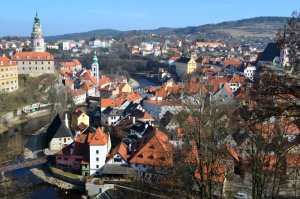 In
a place that had enthralled us since arrival, the views that
presented themselves once we had reached our first post-lunch
objective, the castle gardens, were truly a sight to behold. With
little or no cloud cover to obstruct it, the sun seemed to act like
a spotlight, picking out the haphazardly arranged clusters of
red-roofed buildings, the contrasting shapes of various church
towers, the intricately decorated walls of the castle buildings, the
twisting river attempting to tie the Old Town up in a neat parcel,
and the undulating hills that provided a backdrop to the rest of the scene.
(In the interests of balance, it should be pointed out that the
gardens themselves weren't looking their best at this time of year.)
In
a place that had enthralled us since arrival, the views that
presented themselves once we had reached our first post-lunch
objective, the castle gardens, were truly a sight to behold. With
little or no cloud cover to obstruct it, the sun seemed to act like
a spotlight, picking out the haphazardly arranged clusters of
red-roofed buildings, the contrasting shapes of various church
towers, the intricately decorated walls of the castle buildings, the
twisting river attempting to tie the Old Town up in a neat parcel,
and the undulating hills that provided a backdrop to the rest of the scene.
(In the interests of balance, it should be pointed out that the
gardens themselves weren't looking their best at this time of year.)
When we had fully absorbed the views and fulfilled the quota of photographs demanded by the presentation of such a magnificent vista in optimal weather conditions, we began to walk downwards into the castle itself. Krumlov Castle, formally the State Castle of Český Krumlov, is unusually large for the town in which it is situated, consisting of forty buildings, five courtyards and a park and garden area covering seven hectares. Although fortifications on this site date from the 13th century, the surviving buildings span the 14th to 19th centuries. The complex is considered to be one of the most important historical sites in central Europe. As we continued our walk through the grounds - an experience which was free of charge, incidentally - it was a struggle to decide which was more worthy of attention: the castle buildings themselves, or the breathtaking glimpses of the town below, that opened up intermittently as we progressed.
 |
 |
 |
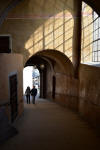 |
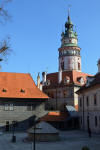 |
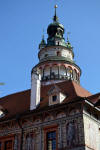 |
 |
 |
 |
|||
| ABOVE: Views within, and looking out from, Krumlov Castle | |||||
| RIGHT: Some final late-afternoon views back at river level |
 |
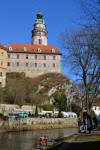 |
 |
In due course we decided to return to river level and have a look around the north-west corner of the central peninsula, which gave another perspective of the town in the slowly weakening sunshine of a late afternoon in March. A well-earned rest then beckoned back at the Hotel Bellevue.
When we re-emerged, duly rested and ready to enjoy our final evening in Bohemia, something odd had happened: the afternoon crowds had simply melted away, leaving the town quiet but certainly not dead. It appeared that most visitors had made plans similar to the original version of our own schedule, treating Krumlov as a day-trip destination from a base elsewhere.
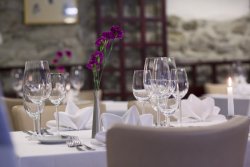 Wandering
along the winding main street of Latrán in search of pre-dinner
drinks, we couldn't help noticing a charming local custom: bars and
restaurants indicated that they were open by decorating their steps
and doorways with lit candles, placed in glass containers to protect
them from the breeze. In a town to which I have already ascribed a
fairytale-like character, it added a further touch of evening magic.
We had properly prepared cocktails (chosen from extensive lists) in
two different hostelries, the very possibility of which seemed
rather impressive in a town of 13,000 souls.
Wandering
along the winding main street of Latrán in search of pre-dinner
drinks, we couldn't help noticing a charming local custom: bars and
restaurants indicated that they were open by decorating their steps
and doorways with lit candles, placed in glass containers to protect
them from the breeze. In a town to which I have already ascribed a
fairytale-like character, it added a further touch of evening magic.
We had properly prepared cocktails (chosen from extensive lists) in
two different hostelries, the very possibility of which seemed
rather impressive in a town of 13,000 souls.
The highlight of the evening was dinner at the superb in-house restaurant Le Jardin at our own hotel, which provided a seemly end to a wonderful day and marked in an appropriate manner the final night of this Bohemian adventure.
The following day we would return first to
Budweis and then onwards to Prague to catch our return BA flight to
the UK. But Krumlov, with the memory of its beautifully restored
medieval streets and castle, seems a fitting place to end this
account of another brilliantly successful trip - one which reminded
us that taking the time to explore a country or a region in a little
more depth can be a hugely enjoyable and rewarding experience. Oh,
and the beer was pretty good, too!
![]()